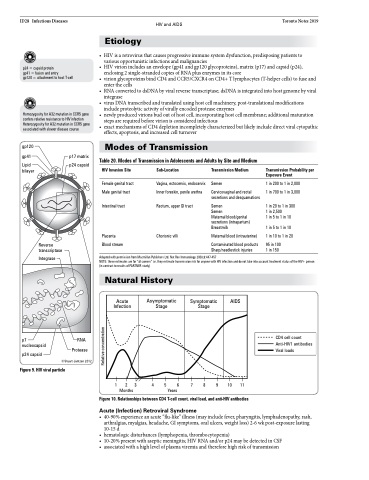Page 628 - TNFlipTest
P. 628
ID28 Infectious Diseases
HIV and AIDS Toronto Notes 2019
p24 = capsid protein
gp41 = fusion and entry
gp120 = attachment to host T-cell
Homozygosity for A32 mutation in CCR5 gene confers relative resistance to HIV infection Heterozygosity for A32 mutation in CCR5 gene associated with slower disease course
Etiology
• HIVisaretrovirusthatcausesprogressiveimmunesystemdysfunction,predisposingpatientsto various opportunistic infections and malignancies
• HIV virion includes an envelope (gp41 and gp120 glycoproteins), matrix (p17) and capsid (p24), enclosing 2 single-stranded copies of RNA plus enzymes in its core
• virionglycoproteinsbindCD4andCCR5/CXCR4onCD4+Tlymphocytes(T-helpercells)tofuseand enter the cells
• RNAconvertedtodsDNAbyviralreversetranscriptase;dsDNAisintegratedintohostgenomebyviral integrase
• virusDNAtranscribedandtranslatedusinghostcellmachinery,post-translationalmodifications include proteolytic activity of virally encoded protease enzymes
• newlyproducedvirionsbudoutofhostcell,incorporatinghostcellmembrane;additionalmaturation steps are required before virion is considered infectious
• exactmechanismsofCD4depletionincompletelycharacterizedbutlikelyincludedirectviralcytopathic effects, apoptosis, and increased cell turnover
gp120
gp41
Lipid bilayer
Integrase
p17 matrix p24 capsid
Modes of Transmission
Table 20. Modes of Transmission in Adolescents and Adults by Site and Medium
HIV Invasion Site
Female genital tract Male genital tract
Intestinal tract
Placenta Blood stream
Sub-Location
Vagina, ectocervix, endocervix Inner foreskin, penile urethra
Rectum, upper GI tract
Chorionic villi
Transmission Medium
Semen
Cervicovaginal and rectal secretions and desquamations
Semen
Semen
Maternal blood/genital secretions (intrapartum) Breastmilk
Maternal blood (intrauterine)
Contaminated blood products Sharp/needlestick injuries
Transmission Probability per Exposure Event
1 in 200 to 1 in 2,000 1 in 700 to 1 in 3,000
1 in 20 to 1 in 300 1 in 2,500
1 in 5 to 1 in 10
1 in 5 to 1 in 10
1 in 10 to 1 in 20
95 in 100 1 in 150
Reverse transcriptase
Adapted with permission from Macmillan Publishers Ltd. Nat Rev Immunology 2008;8:447-457
NOTE: these estimates are for “all comers” i.e. they estimate transmission risk for anyone with HIV infection and do not take into account treatment status of the HIV+ person (in contrast to results of PARTNER study)
Natural History
Acute Infection
Asymptomatic Stage
Symptomatic Stage
AIDS
p7 nucleocapsid
p24 capsid
RNA Protease
Figure 9. HIV viral particle
©Stuart Jantzen 2012
1 2 3 4 5 6 7 8 9 10 11 Months Years
Figure 10. Relationships between CD4 T-cell count, viral load, and anti-HIV antibodies
Acute (Infection) Retroviral Syndrome
• 40-90%experienceanacute“flu-like”illness(mayincludefever,pharyngitis,lymphadenopathy,rash, arthralgias, myalgias, headache, GI symptoms, oral ulcers, weight loss) 2-6 wk post-exposure lasting 10-15 d
• hematologicdisturbances(lymphopenia,thrombocytopenia)
• 10-20%presentwithasepticmeningitis;HIVRNAand/orp24maybedetectedinCSF
• associatedwithahighlevelofplasmaviremiaandthereforehighriskoftransmission
CD4 cell count Anti-HIV1 antibodies Viral loads
Relative concentration


